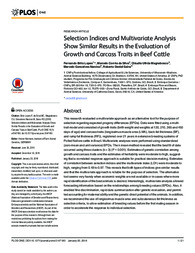Selection indices and multivariate analysis show similar results in the evaluation of growth and carcass traits in beef cattle.
Selection indices and multivariate analysis show similar results in the evaluation of growth and carcass traits in beef cattle.
Autoria: LOPES, F. B.; SILVA, M. C. da; MAGNABOSCO, C. de U.; NARCISO, M. G.; GONZALEZ, R. D. S.
Resumo: This research evaluated a multivariate approach as an alternative tool for the purpose of selection regarding expected progeny differences (EPDs). Data were fitted using a multi- trait model and consisted of growth traits (birth weight and weights at 120, 210, 365 and 450 days of age) and carcass traits (longissimus muscle area (LMA), back-fat thickness (BF), and rump fat thickness (RF)), registered over 21 years in extensive breeding systems of Polled Nellore cattle in Brazil. Multivariate analyses were performed using standardized (zero mean and unit variance) EPDs. The k mean method revealed that the best fit of data occurred using three clusters (k = 3) (P <0.001). Estimates of genetic correlation among growth and carcass traits and the estimates of heritability were moderate to high, suggesting that a correlated response approach is suitable for practical decision making. Estimates of correlation between selection indices and the multivariate index (LD1) were moderate to high, ranging from 0.48 to 0.97. This reveals that both types of indices give similar results and that the multivariate approach is reliable for the purpose of selection. The alternative tool seems very handy when economic weights are not available or in cases where more rapid identification of the best animals is desired. Interestingly, multivariate analysis allowed forecasting information based on the relationships among breeding values (EPDs). Also, it enabled fine discrimination, rapid data summarization after genetic evaluation, and permitted accounting for maternal ability and the genetic direct potential of the animals. In addition, we recommend the use of longissimus muscle area and subcutaneous fat thickness as selection criteria, to allow estimation of breeding values before the first mating season in order to accelerate the response to individual selection.
Ano de publicação: 2016
Tipo de publicação: Artigo de periódico
Unidade: Embrapa Cerrados
Palavras-chave: Análise multivariada, Avaliação genética, Carcaça, Gado nelore
Observações
1 - Por padrão são exibidas publicações dos últimos 20 anos. Para encontrar publicações mais antigas, configure o filtro ano de publicação, colocando o ano a partir do qual você deseja encontrar publicações. O filtro está na coluna da esquerda na busca acima.
2 - Para ler algumas publicações da Embrapa (apenas as que estão em formato ePub), é necessário ter, no celular ou computador, um desses softwares gratuitos. Sistemas Android: Google Play Livros; IOS: iBooks; Windows e Linux: software Calibre.
Acesse outras publicações
Acesse a Base de Dados da Pesquisa Agropecuária (BDPA) para consultar o acervo completo das bibliotecas da Embrapa.

